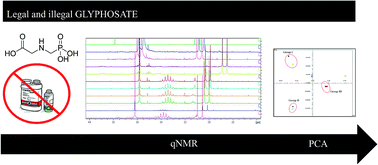Development and validation of a qNMR method for analyses of legal and illegal formulations of glyphosate†
Abstract
Glyphosate is the highest-selling pesticide in Brazil. It is one of the most-seized pesticides by the Brazilian Federal Police. However, smuggled agrochemicals show characteristics unknown from chemical, physical, and biological viewpoints, which should be determined. Quantitative nuclear magnetic resonance (qNMR) spectroscopy is a simple, rapid, and non-destructive methodology that allows simultaneous qualification and quantification of various substances (target and non-target). We developed and validated a method for quantification of the target (glyphosate) in commercial and smuggled products, and qualified the not-target contaminants. Validation was undertaken according to regulation ABNT NBR 14029: 2016 and Association of Analytical Communities criteria. Samples were diluted in D2O and analysed NMR. The method was applied to analyses of 10 glyphosate-based samples: eight commercial and two illegal. All commercial samples demonstrated the percentage of active principle specified by the manufacturer. However, the illegal GLIFP02 sample had a concentration of 33.57% over the reported content. GLIFP01 did not show any formulation description on the label, and showed only 6.10% of active principle in relation to GLIFP02. Also, it was possible to detect polyethoxylated alkyl amine (POEA) in legal and illegal samples. POAE has proven toxicity. Principal component analysis was used to demonstrate that the qNMR method could differentiate between samples of these pesticides. This was the first work to report application of qNMR spectroscopy, an easy, rapid, and non-destructive method, for qualification and quantification of target and not-target compounds in pesticide samples based on glyphosate.



 Please wait while we load your content...
Please wait while we load your content...